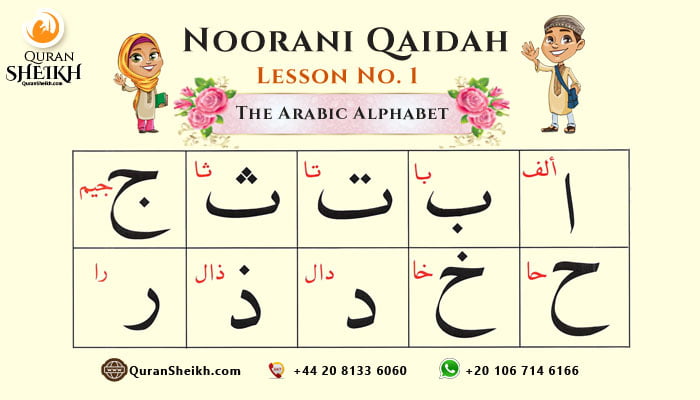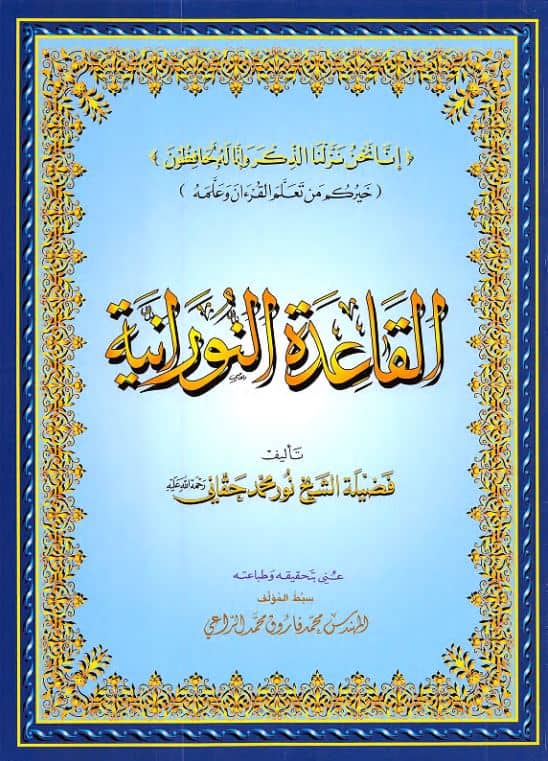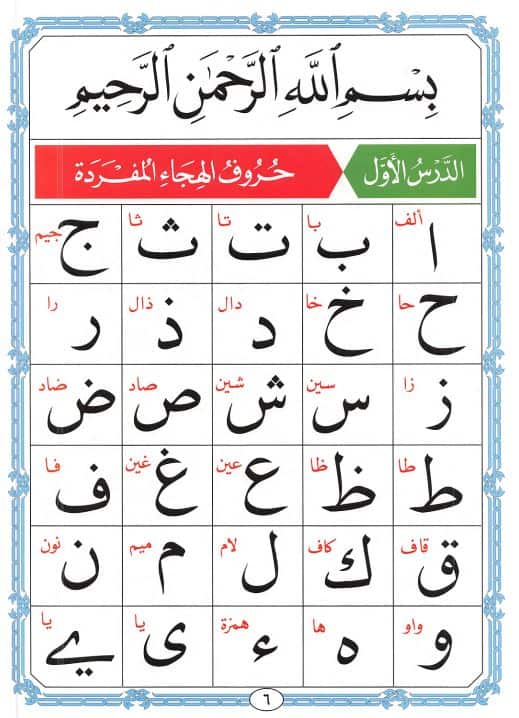Noorani Qaida Lesson 1: We will take you through the series of Noorani Qaida lessons in which you will learn how to read or pronounce the Arabic Alphabet in the least amount of time and least amount of effort so that you can learn how to recite the Noble Quran with proper rules of Tajweed.
Join thousands of Muslim Families who love learning Noorani Qaida & Quran reading from the comfort of their Homes.
Noorani Qaida Lesson 1
After finishing Noorani Qaida Lesson 1, the journey towards learning the Noble Quran will become smooth because this is the foundation of the Arabic language. Once you perfect your Arabic letters then everything else will be easy but until and unless you do not perfect these letters you may face problems while learning the Noble Quran.
The Arabic Language Alphabets
Before going to learn Noorani Qaida lesson 1 you should know the following facts about this lesson:
- There are 29 Arabic letters.
- Out of these 29 letters, only 28 letters have sound and the first letter of this lesson has no sound (ا, Alif).
- Out of these 29 letters, 8 letters are called heavy or bold letters which we will cover in this lesson. These letters are:
خ ، ص ، ض ، غ ، ط ، ق ، ظ ، ر
They are written in a group form as:
خص ضغط قظ
The eight-letter (ر, Raa) is sometimes heavy and sometimes light depending upon the position of the word. The sound of heavy letters is trapped inside the mouth and produce an echo. These letters are pronounced with a heavy and strong voice. While pouncing the light letters the sound is spilled outside of the mouth.
Learn Quran Online fast and easy with a Qualifies Arab teacher, Get 30% OFF join now.
There are three long vowels in Arabic grammar:
ا ، و، ی
- The letter “Alif” produces the sound of “AAA”.
- The letter “Wao” produces the sound of “UUU”.
- The letter “Yaa” produces the sound of “EEE”.
Now we will start our first lesson by describing the pronunciation and origin of all these letters.
Letter ا, الف (Alif):
Pronounce this letter fast. As early it is mentioned that this letter has no sound. It is used to stretch the words in the Arabic language.
This alif is of two types:
- Alif without “ء” or Hamza. This is called vowel and this letter is affected by the letter which comes before it; if that letter is strong then alif will also be strong and vice versa.
For example, in the word قَالَ alif is a vowel and is affected by the letter ق. Since the letter قis strong so alif will also be strong.
- Alif with the letter “Hamza” (أ or إ). In fact it is not Alif now it is name is Hamza.
Precaution: Do not read it as aleef or aaalif. Do not exaggerate or force your throat. This is a soft word in the Arabic language.
Letter ب,با (Baa):
This letter is pronounced by using the inner part of both lips to touch each other.
Precaution: don’t suck the lips in.
Letter ت,تا (Taa):
This letter comes from the flat part of your tongue against the roots of the upper teeth. Try to keep the sound of this letter solid and do not spit it up.
Two common mistakes that people usually make are they pronounce it other than from its home (origin or makhrij).
- They place the tongue behind the bottom teeth while pronouncing it and make a sharp sound which is totally wrong.
- The second mistake that people make is they place the tongue in the roots of upper teeth but spit it out which is also a wrong pronunciation.
So, the right way of pronunciation is to pronounce it with a solid sound.
Letter ث, ثا (Thaa):
This letter has three dots on it. Don’t be confuse with the previous letters. The letter ب has one dot below it, ت has two dots on it.
This letter comes from the flat part of the tongue against the edges of upper teeth softly. Do not press it hardly just contact the tongue with upper teeth.
Precaution: Tongue should be out of the mouth a little bit while pronouncing this letter.
Letter ج,جیم (Jeem):
This letter has a Yaa (a vowel) in the middle to produce the sound of ‘eee’. This letter comes from the middle of the tongue against the upper palate. There is a soft contact of tongue and upper palate while pronouncing this word.
Precaution: Some people loosen this letter and pronounce it like ’yeem’ sound that is incorrect. This is a solid letter and the makhrij of this letter is totally closes. It is also incorrect to pronounce it with گ sound like گِیم.
Letter ح,حا (Haa):
This letter has ‘alif’ as a vowel at the end. This letter comes from the middle of the throat from the epiglottis. The epiglottis is the flap that when we drink or eat something, the epiglottis moves down to close the air passage that leads to our lungs to prevent food or water from going into our lungs. So this epiglottis moves against the back of the throat leaving a very narrow passage from which the air passes through and this is how this letter is pronounced. This letter has a very sharp sound. This letter is pronounced by opening your mouth and apply some force on your throat.
Letter خ,خا (khaa):
This is the first heavy letter of this lesson. It comes from the back of the mouth. When roots of tongue touch the uvula (which is the thing that is hanging in the back of throat) it produces this kind of sound. This should be a soft sound and don’t try to pronounce it by applying force to your throat.
Precaution: This is incorrect to pronounce it like a light letter.
Letter د, دال (Daal):
This letter has alif letter sound in the middle and laam letter sound in the end. This letter comes from the same place as the letter ت (Taa) i.e tip of the tongue touching the roots of the upper teeth.
Letter ذ, ذال (Thaal):
This letter has the same shape as Daal. It can be said that these are the letters of one family. This letter has alif sound in the middle and comes from the same place as the letter ث (Thaa) which is the tip of the upper teeth against the front flat part of the tongue. Do remember this is a soft letter so don’t apply force while pronouncing this letter.
Precaution: As you know that above both letters have a ل (Laam) sound in the end. For this Laam sound, the tongue is placed right after the roots of the upper teeth exactly where the gums begin. This place is called Litha in the Arabic language.
Letter ر,را (Raa):
This is a second heavy letter. This letter is sometimes heavy and sometimes light depending on the position in the Arabic word. But when it is pronounced alone it is always heavy. This letter comes from the front flat part of the tongue against the front palate. We have some ridges right after the upper teeth. The place between these ridges and upper teeth is called the front palate that is the origin of this letter. The back of the tongue is also raised while pronouncing this letter.
Letter ز, زا (Zaa):
This letter has also alif sound at the end. This letter comes from when you place the tip of the tongue behind the tip of the bottom teeth. Tip of the tongue is always towards the tip of the bottom teeth. The sound of this letter is produced from between the tongue and the teeth.
Letter س,سین (Seen):
This letter has Yaa in the middle while pronouncing to produce the sound like ‘eee’. This produces the sharp ‘S’ like sound. This letter comes from the same place as the previous letter ز i.e. tip of the tongue behind the tip of bottom teeth.
Letter ش,شین (Sheen):
This letter is called the sister of the previous letter (س, Seen) because it has the same shape as the previous one except for three dots. Now, this letter comes from the middle of the tongue against the middle of the upper palate. If you remember the letter ج which comes from the same place. The only difference is that while pronouncing the letter ش there is a little bit gap between the tongue and the upper palate through which the sound passes. If you realize that the tongue is suspended here, and the sound is pushed out.
Letter ص,صآد (Saad):
This is a next heavy letter and comes from the same place as the letters ز and س mean the tongue is placed behind the bottom teeth. This letter has alif sound in the middle and د sound in the end. Back of the tongue is raised again here
Precaution: A lot of people use lips while pronouncing this letter which is totally wrong. Don’t need to push the lips out while pronouncing this letter. Lips should be in a normal position.
Letter ض, ضآد (Daad):
This is also a heavy letter, a little bit difficult to pronounce but you can make it easy by practicing it. This letter comes from the front flat part of the tongue against the Laam makhrij which is Lisa (a place where gums begin). Sides of the tongue should touch the inner sides of upper teeth. The sides of the tongue will be pressed against the inner side of the teeth. Tongue should be normal while pronouncing this letter.
Precaution: Don’t touch the tip of tongue with roots of upper teeth. By doing so this will become the letter د. Tip of the tongue should touch the gums only not too high but right after the teeth.
Letter ط, طا (Taa):
This is also a heavy letter. While pronouncing these heavy letters it is necessary to raise the back of the tongue. This letter also comes from the same place as the letter ت which is the root of the upper teeth. Place the flat part of your tongue to upper teeth while raising the back of tongue at the same time and try to produce a heavy sound.
Precaution: Don’t spit out the sound while pronouncing it. Keep the sound solid and contained.
Letter ظ,ظا (ẓāʾ):
This is a next heavy letter. This letter comes from the same place as the letter ذ and ث which is front flat part of the tongue against the edges of upper teeth.
Precaution: Here back of the tongue is also raised. Keep in mind that this is a soft and heavy letter. Don’t apply any force while pronouncing it as in the case of the letter ز.
Letter ع,عین (aeen):
This letter comes from the middle of the throat. This also has a Yaa (ـيـ) in the middle but here this Yaa is not to produce ‘eee’ sound as we have seen in the letter ج. this yaa is a special case in this letter as we pronounce it with fateh. Here flap moves towards the back of the throat and creates a very narrow passage through which the air passes. This is the same thing but tighter than the letter ح. So there is barely any space there for the sound to pass.
Letter غ,غین (goeen):
This is another heavy letter. The pronouncing of this letter is like the previous one but the sound is different. This comes from the same place as the letter خ. but while pronouncing the letter خ the root of the tongue is a little bit down and, in the letter, غ the root of the tongue is little high and touching the uvula. Keep in mind that خ is a dry letter and غ is a wet letter. It produces something like gargling sound. For all the heavy letters the back of the tongue is moved towards the place of غ.
Precaution: don’t pronounce it like a گ letter as there is no such word in the Arabic language.
Letter ف,فا (Faa):
This letter also has an alif letter, in the end, to make it a little bit longer. This letter comes from the inner part of the bottom lip against the edges of the upper teeth.
Letter ق,قاف (Qaaf):
This is the last of the heavy letters. Let pronounce alif in the middle and ف sound in the end. This letter comes from the very last part of the tongue moving up to touch soft palate. Keep this sound solid and don’t spit it up. Also do not click out rather keep it contained.
Letter ک, کاف (kaaf):
This has a little bit similar sound like the previous letter ق. the letter ق comes from the last part of the tongue and this letter comes from a little bit towards the outside. There is a very slightly different between the makhrij of these two letters. The place where the soft palate ends, and the hard palate start is the place of origin of the letter ک.
Precaution: Don’t cough it out while pronouncing this letter. Don’t make an O-shape of lips while pronouncing any one of the heavy letters.
Letter ل,لام (Laam):
This letter has alif in the middle and م sound in the end. This letter also comes from the Litha (a place where gums begin). This letter is like the English letter L.
Letter م, میم (Meem):
This letter has a Yaa (ي) in the middle to pronounce ‘eee’ sound. This letter comes from the lips. Keep your lips normal and do not suck in your lips while pronouncing this letter.
Letter ن,نون (Noon):
This letter has a ‘waao” (و) sound in the middle to produce ‘ooo’ long sound. This letter comes from touching front flat part of the tongue against the front palate.
Precaution: while pronouncing the above three letters, make sure that do not produce sound from nose
Letter و,واو (Waaao):
This letter comes completely from the lips. Do not make a mistake by pronouncing with the inner part of the lips against the edges of upper teeth.
Letter ھ,ھا (Haa):
This letter is very easy to pronounce. It comes from the bottom of the throat producing a deep sound.
Letter ء,ھمزہ (Hamza):
This has a similar shape as ع .it comes from the bottom of the throat from the vocals exactly where the vocals are. when the vocals connect and when they separate, they produce this type of sound. When this letter is combined with other Arabic letters, it produces a fateh sound (a cutting sound instead of Haa sound.
Letter ی,یا (Yaa):
This is the last letter of this lesson. This letter comes from the same place as ج and ش which is the flat part of the tongue touching the upper palate. But there is a space between the tongue and upper palate more than as was in the case of ش.
Special lesson on the Makharij:
Noorani Qaida Lesson 1 (Al Makhrij): Makhrij is defined as articulation or home from which the letter sound is produced. Here we will discuss the neighboring letters or Roommates which means that the letters which have the same place but there are some things that make them slightly different from other letters.
There are nine group of letters:
1. ف ، و ، ب ، م
They all come from the lips
2. ت ، د ، ط
They all come from the front flat part of the tongue against the roots of upper teeth.
3. ث ، ذ ، ظ
They all come from the front flat part of the tongue against the edges of the upper teeth.
4. ج ، ش ، ی
They all come from the middle of the tongue against the middle of the upper palate.
5. ح ، ع
These two letters come from the middle of the throat where epiglottis moves back towards the back of the throat and constricts the passing of the sound and the air.
6. خ ، غ
They come from the top part of the throat where the root of the tongue raises against the uvula.
7. ل ، ن ، ر
These letters come from the front flat part of the tongue against the front flat part of the upper palate. The front palate is between the upper teeth and ridges which is also called Litha.
8. ز ، س ، ص
These letters come from the tip of the tongue against the bottom teeth.
9. ء ، ھ
They come from the bottom of the throat where the vocals are.
Noorani Qaida Course with an Arab teacher, book and get 30% Off
Noorani Qaida Lesson 1 PDF:
Download Noorani Qaida Book as a PDF file, please click on download icon.
Noorani Qaida Online Course:
Quran Sheikh Institute provide you Noorani Qaida course Register now and get 25% OFF.
Start noorani qaida lessons and know how to read Arabic Alphabet up to read Quran with Tajweed insha Allah well.
Read more about our courses





